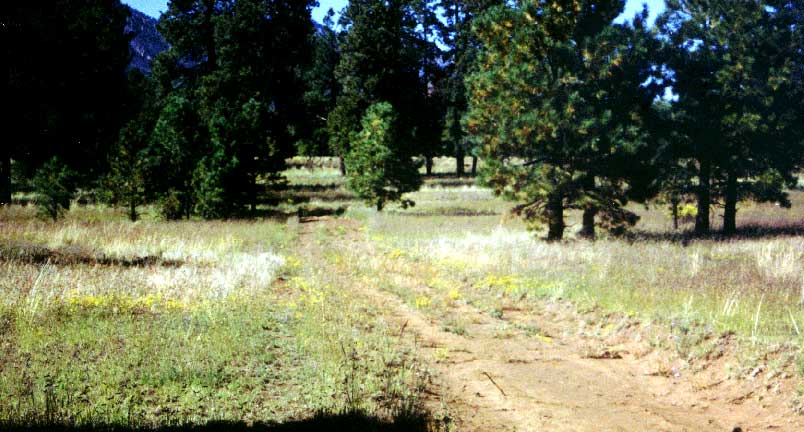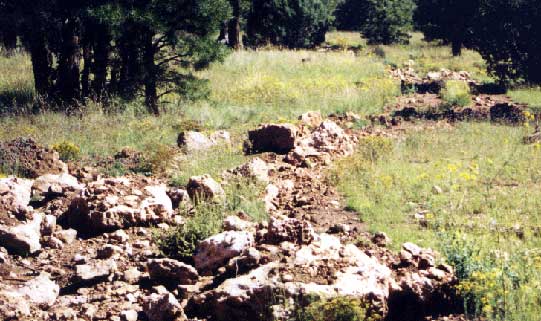
From the Editor
Land closures: What mission accomplished?
FLAGSTAFF, Arizona, September 23, 2003 -- Last fall, the U.S. Forest Service went to considerable trouble to tear up some trails in a section of Coconino National Forest. As you may recall (from Land closures, water supplies, and politics, February, 2003), this involved bringing in a huge piece of roto-tilling equipment to destroy the trails and closing the forest to motor vehicles.
I got curious as to what the area might look like a year later, after a winter's snows and a summer's monsoon rains had smoothed over the roto-tiller's scars a bit. Here's what I found.
Earth to Earth, dust to dust

This stretch of trail looks almost the same as it did before the Forest Service tore it up. Because it was mostly soft Earth, with few embedded rocks and boulders, the snow, rain, and wind that buffet the Flagstaff area have pretty much brought the trail back to the way it was. A certain amount of vegetation has grown up in and along the trail -- probably as a result of the heavy monsoon rains we had this summer. At one point, Flagstaff set a city record with 18 consecutive days of rain.
The Forest Service caves in to environmental groups who can't stand the thought of a few dirt bike riders having some fun.
However, in terms of "returning the land to its natural state," not much has happened. Where there once was a trail, there's still a trail. But as I argued in February's column, the trails in this patch of forest were used very lightly to begin with. When Meg and I lived in an apartment complex adjoining this section of the forest, I used to walk our dogs there quite often. On our walks, I hardly ever saw a soul -- and I almost never saw a motor vehicle. In some 200 walks over a span of two years or so, I probably saw a grand total of 10 dirt bikes and four-wheeled all-terrain vehicles (ATVs) in the forest. And I never saw a single one of them tearing up the landscape or venturing off the trails. Why, then, was it deemed necessary to ban motorized recreation in this area?
At the risk of repeating myself, it was a result of the Forest Service caving in to political pressure from environmental groups who can't stand the thought of a few dirt bike riders venturing onto public land and having some fun.
At the same time, though, the measures actually taken to "prevent" motorized recreation were so half-hearted as to be ludicrous. Exhibit A:

Now, honestly, do you really think this is going to stop a dirt-bike or 4-wheel-drive vehicle from riding the trail? Any self-respecting Jeep driver would yawn in the general direction of such an obstacle, before opening the throttle and driving over the log as if it weren't there.
The boulders in the following picture would be more difficult, if not impossible, to negotiate. But although the trail itself is pretty close to impassable, you could easily drive along right next to it with no trouble at all. What has the Forest Service accomplished by ripping up the trail?

In some parts of the forest, slightly more sensible measures have been taken. Here, they've covered one side of a dual-track trail with rocks and logs, so that it's effectively only a single-track trail (see below).
I say "slightly more sensible" because it reduces the width of the trail while still allowing hiking and pedal biking. (Obviously, however, a motorized dirt bike would be unaffected -- and in fact, you could drive a Cadillac along the trail easily enough, with one side of the car on the single-track and the other side next to the trail).

So what is the point?
I won't belabor the point, since these photos speak for themselves. It should be obvious that no useful purpose has been served by this land closure and trail "removal." The few dirt bikes and ATVs that used to use this patch of forest were causing no damage to begin with, and they're causing no damage now. The Forest Service spent a certain amount of money "removing" the trails and putting up signs announcing the ban on motor vehicles. But the amount of environmental "good" accomplished by these measures amounts to a big fat zero.
Banning dirt bikes may make the Greens happy, but in terms of actually helping Mother Earth, it'll accomplish nothing.
Meanwhile, residents of east Flagstaff who want to engage in the legal activity of riding dirt bikes have one less option available. Which means they'll spend more time in the few areas in which off-road riding is still allowed -- increasing the wear and tear on those areas and prompting local environmental groups to decry the "destruction" they're causing. Until eventually, no off-road riding is allowed anywhere, anytime, on public land. This may make the Greens happy, but in terms of actually helping Mother Earth, it'll do nothing.
My concern here is not whether a particular square mile of National Forest allows dirt bikes or doesn't allow them. That's no big deal. But taken as a whole, environmental issues are an area that tends to foster well-meaning regulatory or legislative moves that (a) fail to address the perceived problems they're intended to fix, and (b) cause a lot of unintended consequences.
Follow the money!
Just to take another example briefly, let's look at automotive emissions testing regulations. I don't know anyone who's against clean air -- but the way emissions testing is implemented in many states does little to clean up the air, instead serving largely to line the pockets of car dealers and testing equipment manufacturers. (It's no coincidence that the company that makes most of the testing machines spends millions of dollars a year lobbying state legislatures to adopt ever-tighter emissions standards, so they'll have to buy exhaust sniffers. For some eye-opening articles on this subject, just go to Google and search for ENVIROTEST LOBBYING -- Envirotest makes most of the emissions testing gear used in the United States.) One source notes that in Illinois, only 8.4% of all cars tested failed to meet the standards, and almost all of those cars were from model years 1990 and older (i.e., cars that aren't going to last much longer anyway). That being the case, why bother testing newer cars? They're not the ones doing the polluting. Testing those cars is a waste of time and money -- but it's an economic boon for Envirotest. I doubt this is what the legislators who wrote the Clean Air Act had in mind. And let's not even get into the fact that the vehicles that put out the most exhaust -- SUVs -- are subject to much less stringent emissions standards than passenger cars.
As I've argued before, governments are less interested in enacting good legislation than in appearing to enact good legislation. And in the environmental arena, because the issues are so emotional, the laws that accomplish their goals without unintended adverse consequences are few and far between. Green laws are seldom based on solid scientific research, they've usually got loopholes you can drive an SUV through, and they often fail to produce the environmental-quality benefits their authors intended.
Copyright © 2003 Kafalas.com, LLC
Feedback?
Fire off a letter to the editor,
and I'll post it on the letters page.
Letters may be edited for clarity or length.
Return to the home page